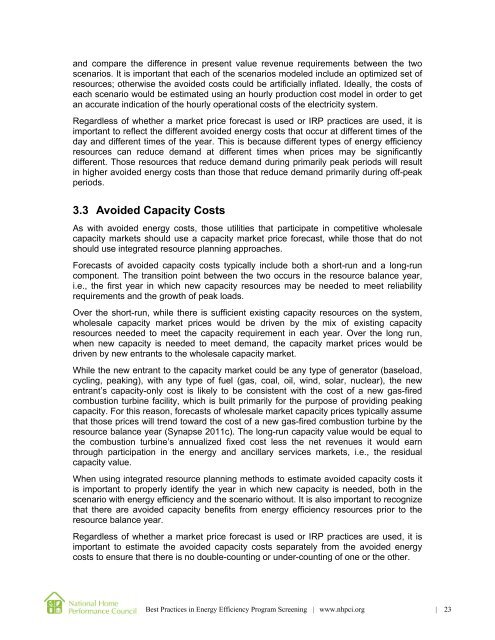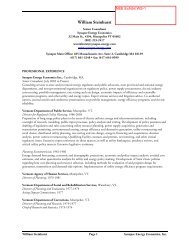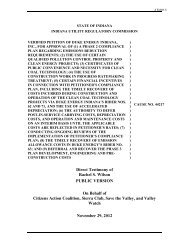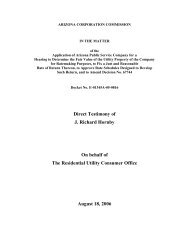Best Practices in Energy Efficiency Program Screening - Synapse ...
Best Practices in Energy Efficiency Program Screening - Synapse ...
Best Practices in Energy Efficiency Program Screening - Synapse ...
You also want an ePaper? Increase the reach of your titles
YUMPU automatically turns print PDFs into web optimized ePapers that Google loves.
and compare the difference <strong>in</strong> present value revenue requirements between the two<br />
scenarios. It is important that each of the scenarios modeled <strong>in</strong>clude an optimized set of<br />
resources; otherwise the avoided costs could be artificially <strong>in</strong>flated. Ideally, the costs of<br />
each scenario would be estimated us<strong>in</strong>g an hourly production cost model <strong>in</strong> order to get<br />
an accurate <strong>in</strong>dication of the hourly operational costs of the electricity system.<br />
Regardless of whether a market price forecast is used or IRP practices are used, it is<br />
important to reflect the different avoided energy costs that occur at different times of the<br />
day and different times of the year. This is because different types of energy efficiency<br />
resources can reduce demand at different times when prices may be significantly<br />
different. Those resources that reduce demand dur<strong>in</strong>g primarily peak periods will result<br />
<strong>in</strong> higher avoided energy costs than those that reduce demand primarily dur<strong>in</strong>g off-peak<br />
periods.<br />
3.3 Avoided Capacity Costs<br />
As with avoided energy costs, those utilities that participate <strong>in</strong> competitive wholesale<br />
capacity markets should use a capacity market price forecast, while those that do not<br />
should use <strong>in</strong>tegrated resource plann<strong>in</strong>g approaches.<br />
Forecasts of avoided capacity costs typically <strong>in</strong>clude both a short-run and a long-run<br />
component. The transition po<strong>in</strong>t between the two occurs <strong>in</strong> the resource balance year,<br />
i.e., the first year <strong>in</strong> which new capacity resources may be needed to meet reliability<br />
requirements and the growth of peak loads.<br />
Over the short-run, while there is sufficient exist<strong>in</strong>g capacity resources on the system,<br />
wholesale capacity market prices would be driven by the mix of exist<strong>in</strong>g capacity<br />
resources needed to meet the capacity requirement <strong>in</strong> each year. Over the long run,<br />
when new capacity is needed to meet demand, the capacity market prices would be<br />
driven by new entrants to the wholesale capacity market.<br />
While the new entrant to the capacity market could be any type of generator (baseload,<br />
cycl<strong>in</strong>g, peak<strong>in</strong>g), with any type of fuel (gas, coal, oil, w<strong>in</strong>d, solar, nuclear), the new<br />
entrant’s capacity-only cost is likely to be consistent with the cost of a new gas-fired<br />
combustion turb<strong>in</strong>e facility, which is built primarily for the purpose of provid<strong>in</strong>g peak<strong>in</strong>g<br />
capacity. For this reason, forecasts of wholesale market capacity prices typically assume<br />
that those prices will trend toward the cost of a new gas-fired combustion turb<strong>in</strong>e by the<br />
resource balance year (<strong>Synapse</strong> 2011c). The long-run capacity value would be equal to<br />
the combustion turb<strong>in</strong>e’s annualized fixed cost less the net revenues it would earn<br />
through participation <strong>in</strong> the energy and ancillary services markets, i.e., the residual<br />
capacity value.<br />
When us<strong>in</strong>g <strong>in</strong>tegrated resource plann<strong>in</strong>g methods to estimate avoided capacity costs it<br />
is important to properly identify the year <strong>in</strong> which new capacity is needed, both <strong>in</strong> the<br />
scenario with energy efficiency and the scenario without. It is also important to recognize<br />
that there are avoided capacity benefits from energy efficiency resources prior to the<br />
resource balance year.<br />
Regardless of whether a market price forecast is used or IRP practices are used, it is<br />
important to estimate the avoided capacity costs separately from the avoided energy<br />
costs to ensure that there is no double-count<strong>in</strong>g or under-count<strong>in</strong>g of one or the other.<br />
<strong>Best</strong> <strong>Practices</strong> <strong>in</strong> <strong>Energy</strong> <strong>Efficiency</strong> <strong>Program</strong> Screen<strong>in</strong>g | www.nhpci.org | 23







